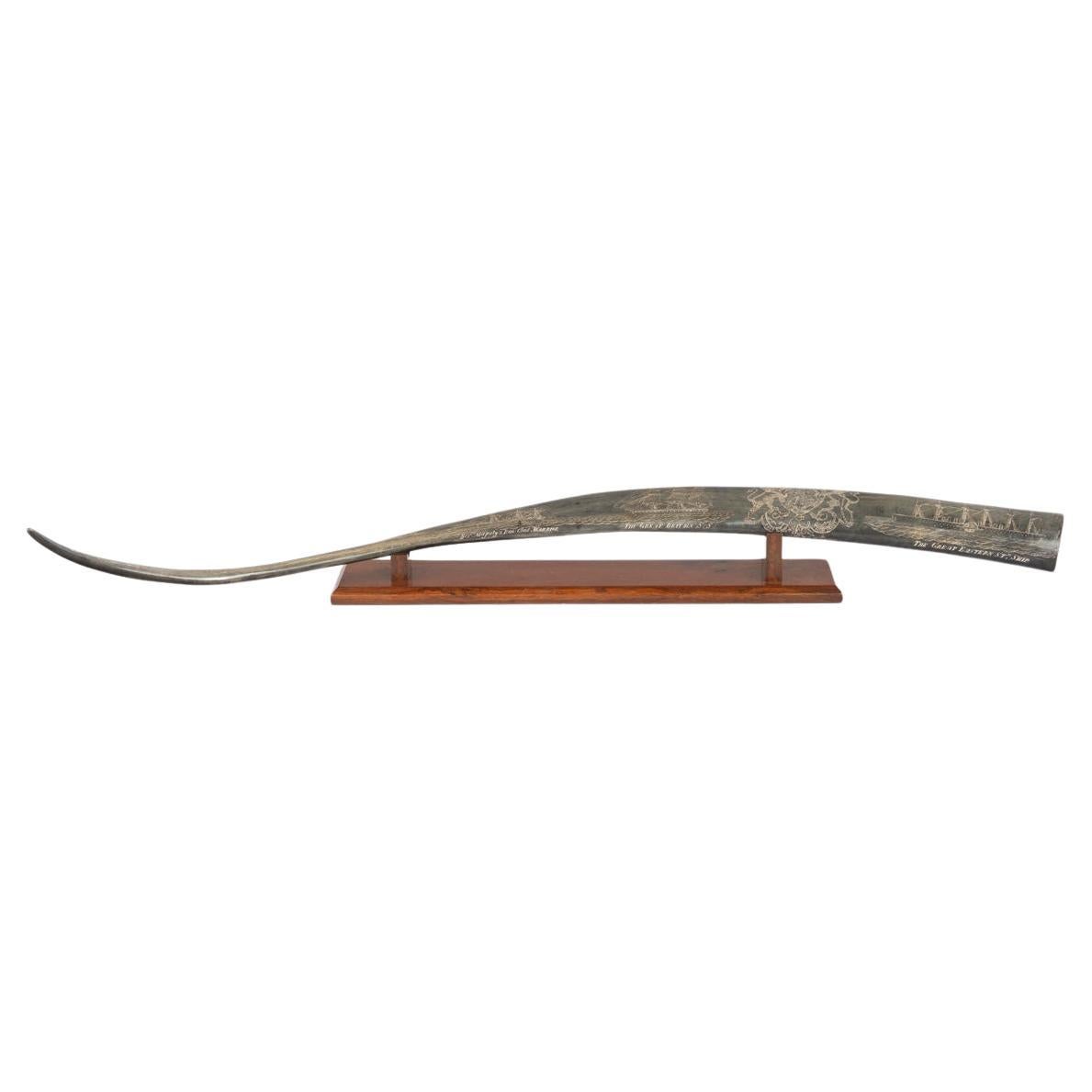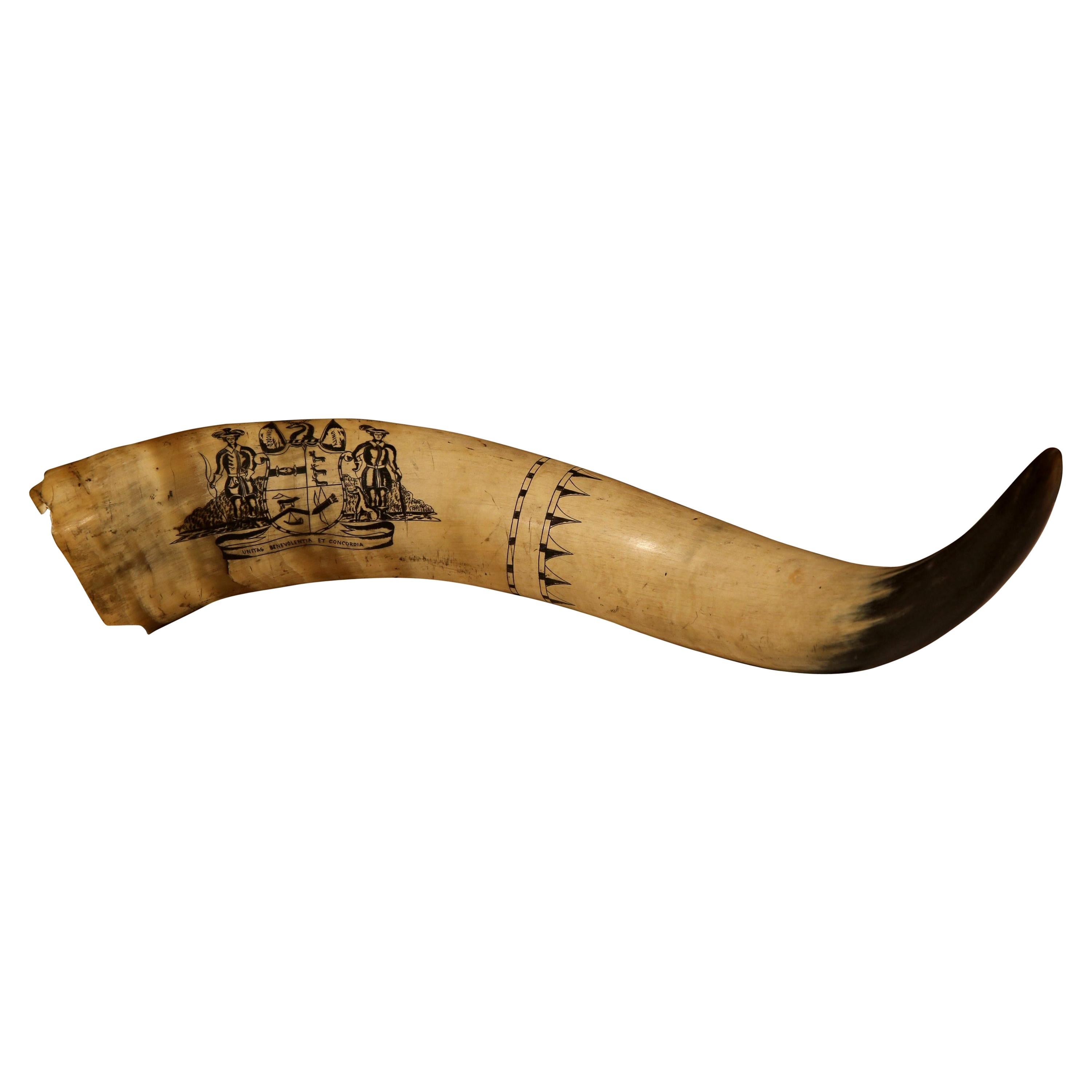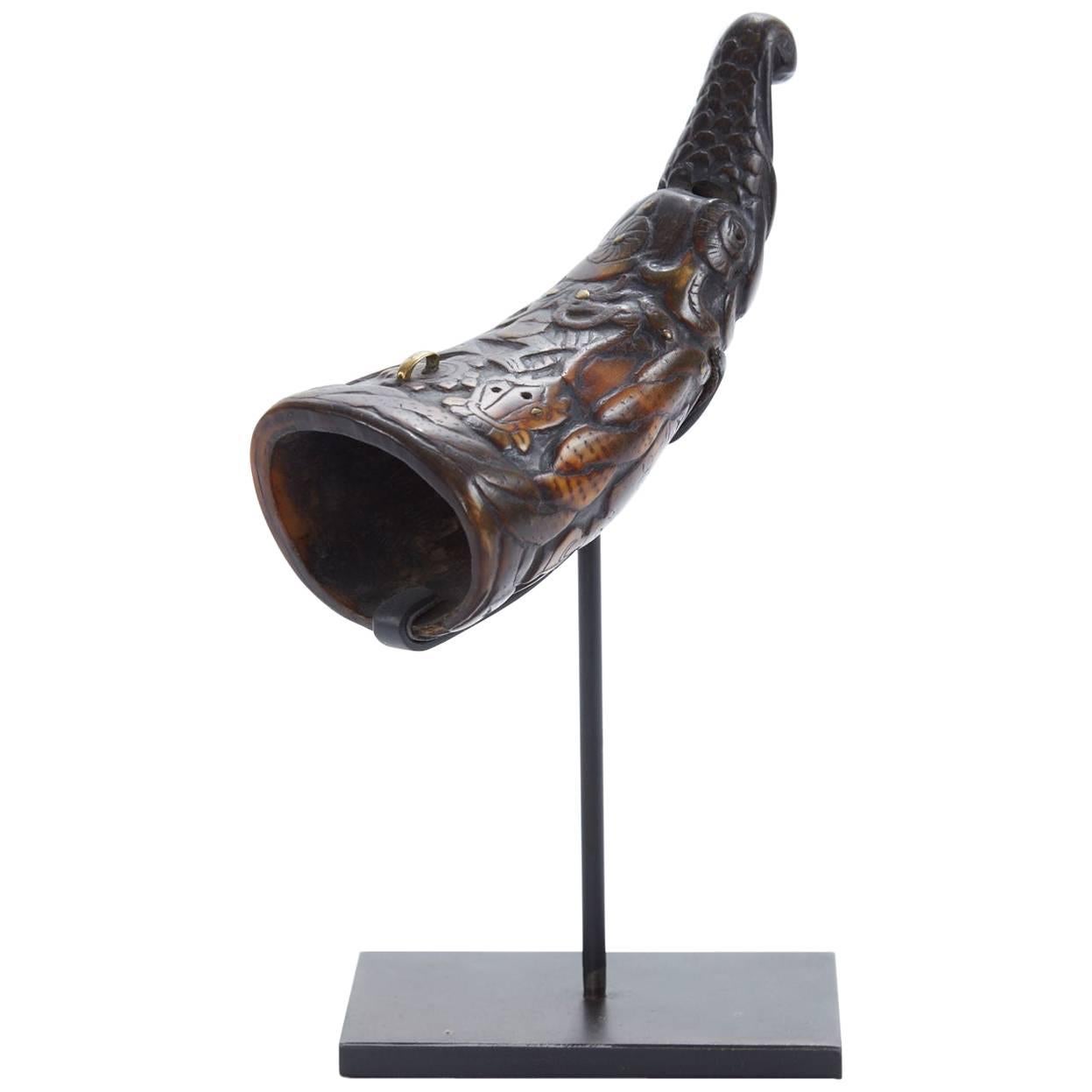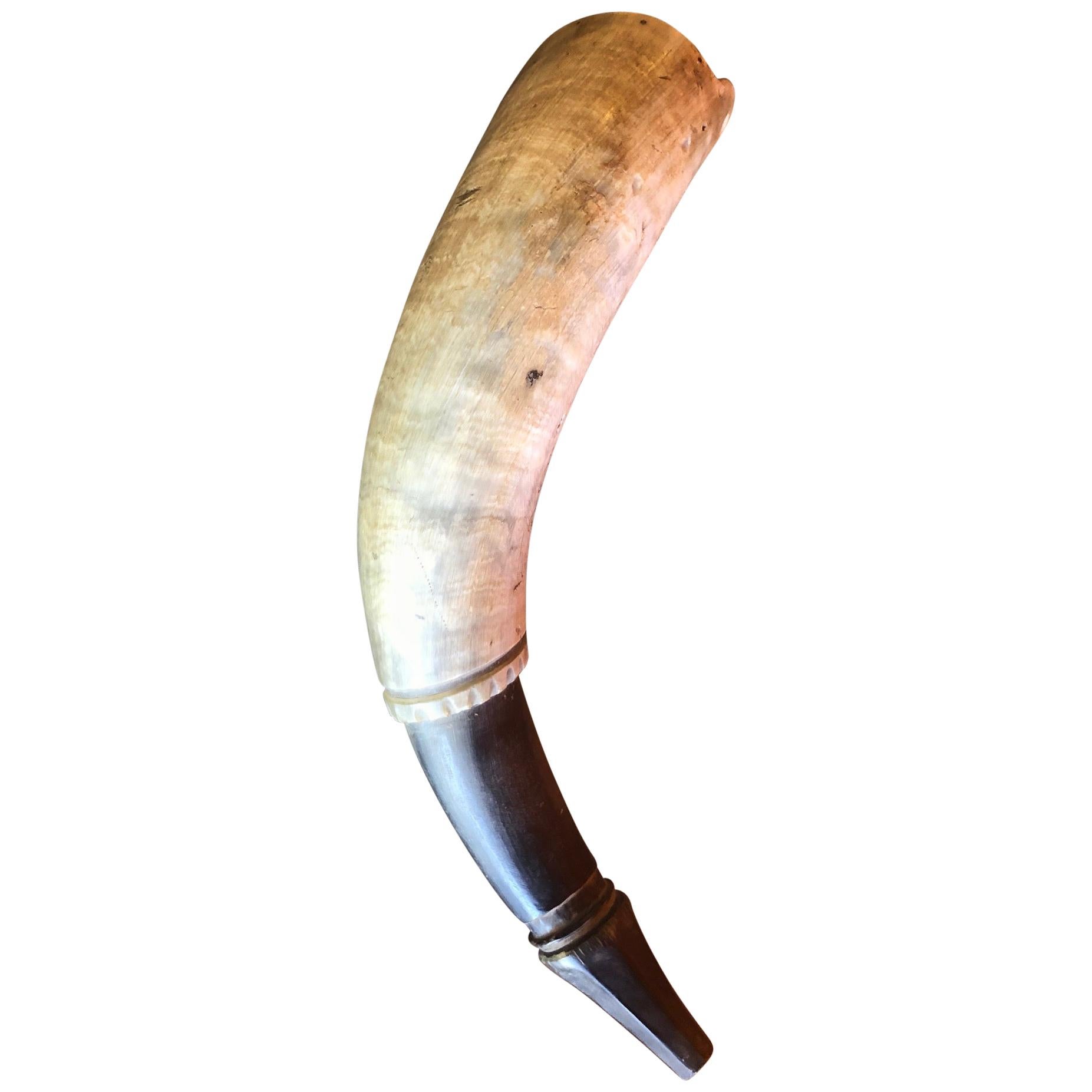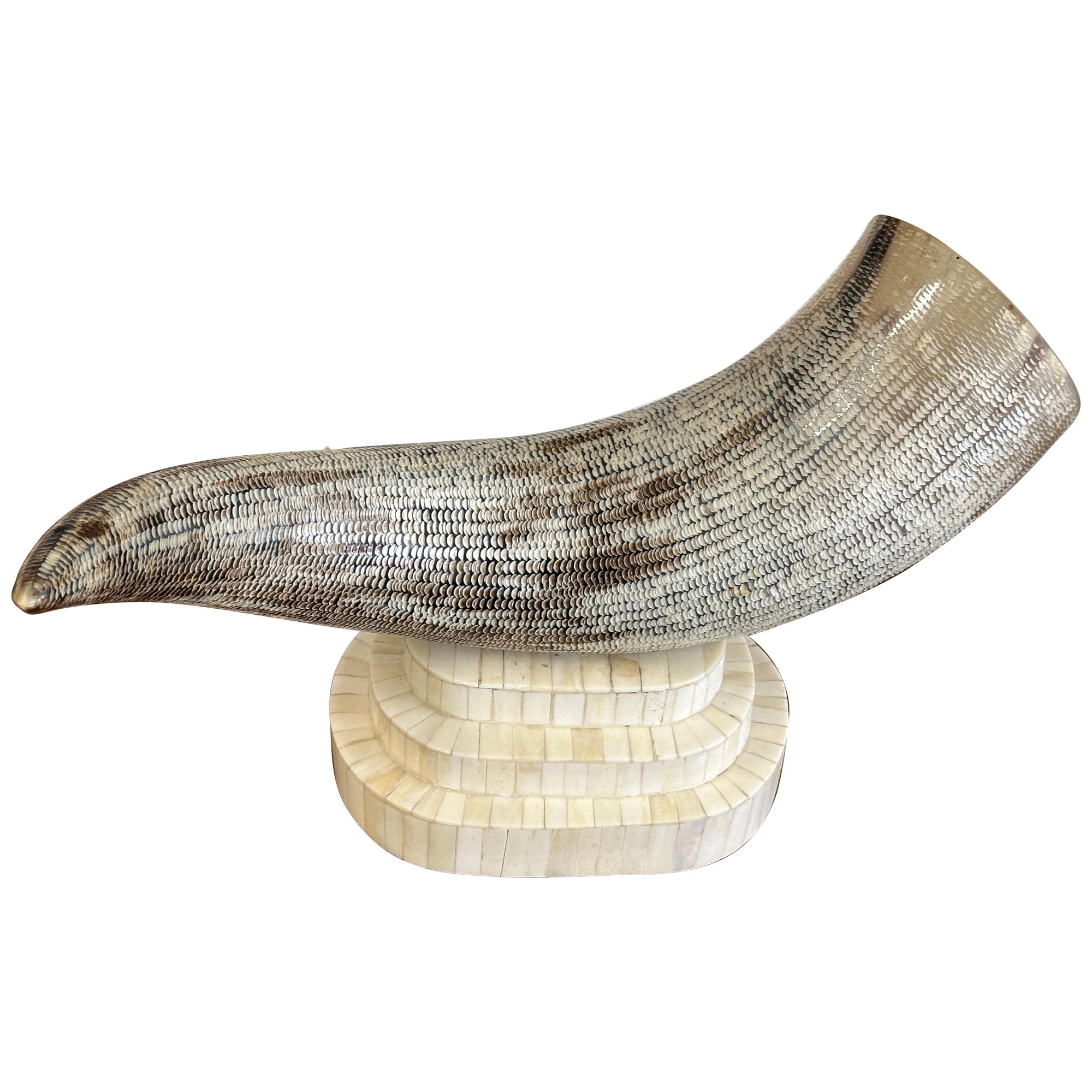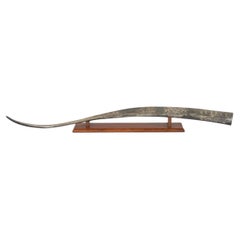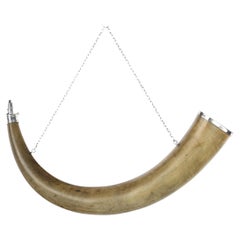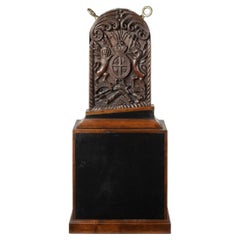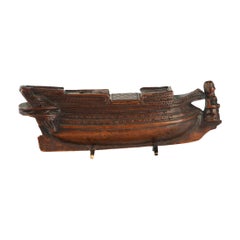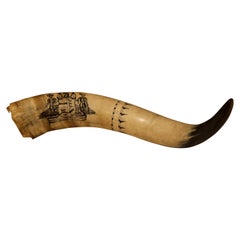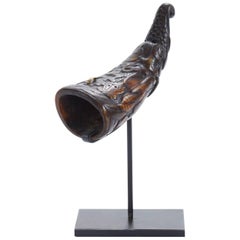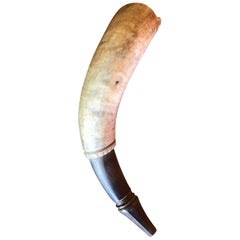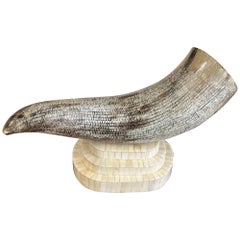Items Similar to A rare scrimshaw decorated horn signed by C.H. Wood
Want more images or videos?
Request additional images or videos from the seller
1 of 19
A rare scrimshaw decorated horn signed by C.H. Wood
$11,926.78
£8,700
€10,221.56
CA$16,709.28
A$18,338.28
CHF 9,457.57
MX$219,063.99
NOK 119,844.91
SEK 112,300.25
DKK 76,335.82
About the Item
A rare scrimshaw decorated horn signed by C.H. Wood. Each curled horn is ornately carved with important motif’s relating to the Battle of Trafalgar and iconic battleships. Our two horns are fascinating examples of the work of this extremely talented man and are truly museum quality pieces in themselves.
A Rare Scrimshaw Decorated Horn
The poem can be found below;
Lines
Britannia’s favourite and his sovereign’s pride
He rul’d despotic Lord of ocean’s tide
Each coast remember’d for some deed of fame
Was made illustrious by Great Nelson’s name
Denmark, Iberia, Eygpt’s tropical shore
Heard the dread’ thunder of his cannon roar
While laurels won from ev’ry hostile fleet
He laid in triumph at his Monarch’s feet
And history ever shall record the day
Bright with his glory in Trafalgar’s Bay
Thro’ every chine he’d sought but sought in vain
The still retreating fleets of France and Spain
When found at last he crush’d them on the flood
And seal’d the awful conquest with his blood
Signed on reverse.
Footnote:
Little is known about the mysterious C. H. Wood but it has now been established by good reasonable doubt that he was born Charles H. Wood and, according to new sources we have discovered, he was a Liverpool man and at one point worked for a Mr Winsland, builder in London. He was English by birth but enjoyed a truly international career, seemingly working in both America and Australia and exhibiting his exceptional productions on board ships and at ports. In her article Advance Australia: C. H. Wood, Embellisher-of-Sea-Shells, Ox-Horn and Whale-Ivory, published in Australiana, November 1992, Susan M. Frank describes Wood’s career as an engraver beginning as follows:
‘In June 1845, on the occasion of the maiden transatlantic voyage of Isambard Kingdom Brunel’s revolutionary steamship Great Britain, an obscure English engraver named C. H. Wood produced a elaborate presentation piece expertly incised in the manner of whalemen’s scrimshaw on the voluminous inner surface of a large seashell. Featuring portraits of the Great Britain and Great Western (another of Brunel’s ocean-going leviathans, launched in 1837), the shell was dedicated to Queen Victoria and consort Prince Albert, to whom Wood presented it as a gift. Whether or not this presentation was ever actually acknowledged at Windsor Castle, it marks the debut of Wood’s progression of royal patronage into a thriving scrimshaw business. His entire subsequent career and reputation in the English press were inextricably linked to the fame and ill-starred fortunes of Brunel’s controversial ships.’
Later in the article, Frank refers to Wood’s engraved and signed nautilus and conch pieces:
‘In the same period when he was making shellwork souvenirs Wood was evidently also engaged in engraving bovine horn, but none have survived. He and his tenuous royal connections continued. Most of it was with the English Royal Family and most of it was conducted from 1845 until 1857. Each new development in the English Royal Family was signalled by engraved shells, complete with commemorative inscriptions and poems, one signed by the engraver C. H. Wood, horn embellisher to HHRH Fred and HHRH Prince Consort (sic). It seems unlikely that he ever ventured further than the Yankee whale fishery and on this or some other occasion may have visited Australia.’
The two engraved horns now on collection, one signed and one not, add further to this small corpus of surviving pieces. Wood is believed to have exhibited his carved shells at the Great Exhibition in 1851 and the International Exhibition of 1862. A nautilus shell engraved with a view of the Great Eastern steamship is in the collection of the Yale Center for British Art.
another is in the SS Great Britain Museum
and a conch shell engraved to commemorate the death of Prince Albert is in the British Museum
Susan M. Frank also contributed an article on Wood to the Dictionary of Scrimshaw Artists, published in 1991.
Research in the British Newspaper Archive has allowed us to shed further light on Wood’s career and work. The first reference we discovered is in Carlisle Patriot, dated the 24th of January 1845. Wood is described as
‘an artisan in the employ of Mr Winsland, builder, London’ and the article relates the story of his presenting a shell to the King and Queen.
On the 25th of April 1849, Wood found himself in front of a judge having been accused of stealing two pairs of children’s shoes when drunk. The case was dismissed but not before an account of Wood’s talent was given to the court. An account in the London Evening Standard, on the 26th of April reveals that Wood’s engraved shell, mentioned in Frank’s article, was indeed accepted by the Royal family and that ‘a sum in gold was presented to him in return by his Sovereign’. He later received a package from the Queen including a framed proof engraving of the coronation by Hayter. Another article on this same court case was published in John Bull on the 30th of April 1849. There is further material of interest in this piece as it describes the fact that Wood made his way to sell two of his engraved shells to a lady who had agreed to purchase them before he got drunk. Additionally, the article states that Wood’s lawyer told the court that Wood had
‘gained great celebrity for his power of engraving on shells. Although a painter, he had taught himself to engrave in the most beautiful manner on shells’.
This is the only reference located so far that refers to Wood’s profession and, as such, is extremely interesting.
Perhaps more fascinating still is an article published in the Liverpool Daily Post on the 26th of October 1861. It reads:
‘Mr C. H. Wood, the celebrated shell engraver connected with the Great Eastern, in accordance of his usual custom of bestowing an engraved shell on the mayor of whatever port the ship may enter, intends in a day or two to present one of his wonderful specimens to our worthy chief magistrate’
These newspaper accounts do suggest that the reason that Wood’s pieces survive is that they were almost always treasured presentation pieces and not tourist souvenirs as has been thought to be the case until now. A further newspaper account, published long after Wood’s death in the Huddersfield and Holmfirth Examiner on the 21st of November 1964 sheds further light on Wood and his activities. The article illustrates two career nautilus shells which had passed down through the family of a Mrs Crowther to her granddaughter Mrs Byram.
‘Apparently the Crowthers became very friendly with the captain on their journey (aboard the Great Eastern) and he gave them the shells to remind them of the Great Eastern.
Obviously the captain C. H. Wood (was like many sailors) good with his hands, and the shells are beautifully inscribed.’
If the article is to be believed then it would seem that Mr Wood was captain of the Great Eastern. However a list of the captains on the ship does not include Wood’s name so this seems likely to have been a mistake made by the journalist at the time.
An article published in the Ulverston Mirror and Furness Reflector on the 6th of September 1862 quotes from another article published in the “Preston paper”. It records Wood presenting an engraved shell to the Mayor of Preston that same year as well as a sculptured bullova egg which he gave to the Mayoress. There are three details in this article which are of particular interest. The first is that Wood is described as ‘Mr C. H. Wood of Liverpool, sculptor and engraver on shells’, seemingly establishing a little more about the life of this fascinating man. Secondly the article ends by mentioning that Wood whilst connected with the Great Eastern made similar presents to the mayors of London, Southampton, Cork, Liverpool &c., suggesting that Wood was no longer connected to the ship at this stage. Finally, the description of the shell presented to the Mayor of Preston includes ‘a beautifully engraved figure, representing Peace, seated on the prow of a vessel, and pointing to the victory achieved by the great English hero Nelson’. This demonstrates that Wood had used Nelson as a subject and strengthens the attribution of our unsigned piece to the master.
In addition to the range of shells engraved by Wood discussed above, there is also one other carved horn which is attributed to Wood and is known as The Horn of Australia due to its iconography relating to that country. It is in the collection of the Kendall Whaling Museum in the US but is now on loan to the Australian National Maritime Museum, Sydney.
- Dimensions:Height: 4.25 in (10.8 cm)Width: 3.5 in (8.89 cm)Depth: 28 in (71.12 cm)
- Materials and Techniques:
- Place of Origin:
- Period:
- Date of Manufacture:1830–1870
- Condition:Wear consistent with age and use. Good.
- Seller Location:Lymington, GB
- Reference Number:1stDibs: LU973047068952
About the Seller
5.0
Recognized Seller
These prestigious sellers are industry leaders and represent the highest echelon for item quality and design.
Established in 1982
1stDibs seller since 2013
137 sales on 1stDibs
Typical response time: 1 hour
Associations
LAPADA - The Association of Arts & Antiques Dealers
- ShippingRetrieving quote...Shipping from: Lymington, United Kingdom
- Return Policy
Authenticity Guarantee
In the unlikely event there’s an issue with an item’s authenticity, contact us within 1 year for a full refund. DetailsMoney-Back Guarantee
If your item is not as described, is damaged in transit, or does not arrive, contact us within 7 days for a full refund. Details24-Hour Cancellation
You have a 24-hour grace period in which to reconsider your purchase, with no questions asked.Vetted Professional Sellers
Our world-class sellers must adhere to strict standards for service and quality, maintaining the integrity of our listings.Price-Match Guarantee
If you find that a seller listed the same item for a lower price elsewhere, we’ll match it.Trusted Global Delivery
Our best-in-class carrier network provides specialized shipping options worldwide, including custom delivery.More From This Seller
View AllA rare scrimshaw decorated horn Signed and inscribed by the base by C. Wood
Located in Lymington, Hampshire
A rare scrimshaw decorated horn, engraved over one side with the Royal Arms countersigned and titled ship profiles for the Great Eastern, the Great Britain,...
Category
Antique 1860s English Nautical Objects
Materials
Horn
A Very Fine and Historically Significant George III Silver Mounted Powder Horn
Located in Lymington, Hampshire
This fine powder horn has silver mounts by the silversmiths Thomas Phipps and Edward Robinson, hallmarked for London, 1803. The charger on the horn has three adjustments and a side lever system and the wider end of the horn has a silver cap engraved with two crests, shields and family mottoes. The crests are for the Maitland and Dick families and represent the lineage of Rear-Admiral Sir Frederick Lewis Maitland. The Maitland line, represented by the lion crest and the motto Consilio et Animus represents the arms of the male line. Maitland’s father, also Frederick Lewis Maitland (1730-1786), had an interesting and successful naval career though was rather overshadowed by the later successes of his son. The martlet (small bird) crest and motto In Domino Confido is the female line, in this case Margaret Dick, daughter of Viscount Frendraught. The Dick family was important in the clan hierarchy in Scotland, being the head of Clan Crichton and heir to Clan Makgill at this time.
Provenance
Rear-Admiral Sir Frederick Lewis Maitland KCB (1777-1839) and thence by descent
Rear-Admiral Sir Frederick Lewis Maitland KCB (1777-1839)
Born in Fife, Maitland was the father of a distinguished naval officer as discussed above. Mailtand joined the navy straight from school and, whilst serving on the frigate HMS Southampton under captain Robert Forbes...
Category
Antique Early 19th Century English George III Nautical Objects
Materials
Silver
Royal Naval Ship’s Elm Companionway Board
Located in Lymington, Hampshire
A Royal Naval ship’s elm companionway board, of rectangular form with an arched top and two sturdy brass rings, naively carved with a crowned coat of arms flanked by a lion and unicorn...
Category
Antique 1860s English Nautical Objects
Materials
Elm
A carved boxwood prisoner of war battleship snuff box
Located in Lymington, Hampshire
A carved boxwood prisoner of war battleship snuff box. This small snuff box is carved in the form of a 112-gun ship of the line with a removable quarte...
Category
Antique 19th Century English Snuff Boxes and Tobacco Boxes
Materials
Boxwood
Large Elm Tiller from the Brixam Fishing Trawler 'Provident'
Located in Lymington, Hampshire
A large elm tiller with a bronze helm and turned finial from the Brixham fishing trawler 'Provident', 1924
Provident details:
Builder: J Sander...
Category
Vintage 1920s English Sports Equipment and Memorabilia
Materials
Elm
Royal Southampton Yacht Club Cannon
Located in Lymington, Hampshire
This pair of early Victorian three-stage bronze signal cannon are set on elm carriages with bronze fittings.
Each 39 inch tapering barrel has one reduction and a ball cascabel. Th...
Category
Antique 1840s English Historical Memorabilia
Materials
Bronze
You May Also Like
19th Century English Scrimshaw Steer Horn with Black Armorial Crest Engraving
Located in Dallas, TX
Decorate a man's office with this fine, antique scrimshaw steer Horn. Found in England, circa 1870, the Horn flaunts impressive engraving work and ov...
Category
Antique Late 19th Century English More Desk Accessories
Materials
Horn
Late 19th Century Hand-Carved ritual 'Thun Rwa' Horn with Gold Inlay
Located in Wainscott, NY
Late 19th century hand-carved 'Thun Rwa' horn was used commonly by the Ngakpa (lay Lamas) of Tibet. Used as a healing tool with medicinal/herbal powders, the tribe "Medicine Man" wou...
Category
Antique Late 19th Century Burkinabe Mounted Objects
Materials
Gold
19th Century Antique Powder Horn with Scrimshaw
Located in San Diego, CA
Rare 19th century antique powder horn with scrimshaw, circa 1872. The horn is inscribed "Charles Lee" in scroll on the side of the horn and the woo...
Category
Antique Mid-19th Century American Folk Art Sculptures and Carvings
Materials
Metal
$1,200 Sale Price
20% Off
Carved Etched Horn Mounted on a Tesselated Bone Base
Located in Palm Springs, CA
An interesting decorative sculpture, this etched horn is mounted on a tesselated bone base. It is very much in the style of Maitland Smith or a similar company. The horn is likely a ...
Category
20th Century Unknown Natural Specimens
Materials
Bone, Horn
Decorative Horn with Brass Closure and Brass Tip for Storage, Drinking, 420
Located in Los Angeles, CA
A beautiful horn - typically used as a drinking cup on the camp, or storage of anything from gunpowder to tobacco - today, with the addition of a beaurtiful brass hinged top and adde...
Category
20th Century English Rustic Tribal Art
Materials
Brass
Powder keg. Engraved horn, rope, cork. Spain, 19th century.
Located in Madrid, ES
Powder keg. Engraved horn, rope, cork. Spain, 19th century.
A container for storing gunpowder made from a cow's horn and decorated on the outside with a series of figurative, geomet...
Category
Antique 19th Century Spanish Neoclassical Revival Sports Equipment and M...
Materials
Metal, Other
